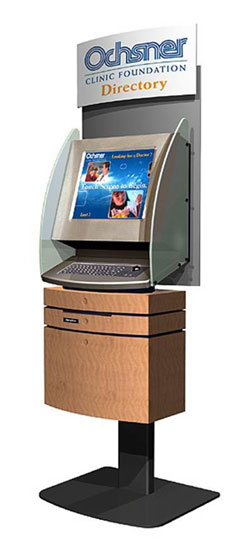Article
Medical facility finding its way around self-service
Ochsner Clinic Foundation boosts visitor satisfaction with wayfinding kiosks. The organization plans to add more kiosks and applications.
October 7, 2003
Call it destiny. Marketing firm and technology integrator Kiosk Learning Centers had identified the healthcare environment as one with plenty of opportunities for self-service applications, while New Orleans-based Ochsner Clinic Foundation was investigating ways to help its patients find information on its facilities and services.
Kiosk Learning Centers pitched an idea for kiosks to Ochsner, and the immediate need the facility mentioned was wayfinding. Ochsner is a 441-bed hospital, employing more than 500 physicians in nearly 70 medical specialties. The foundation offers services in more than 30 locations throughout Southeast Louisiana.
Ochsner sent out proposal requests and interviewed three kiosk companies. The foundation selected Kiosk Learning Centers based on an integrated solution, according to Lisa Fine, vice president of marketing, public affairs and planning at Ochsner.
Growing deployment
Kiosk Learning Centers has had a five-kiosk pilot in place since July. Plans now call for five more kiosks to be deployed on the Ochsner campus, and another two units to be added to a remote site. The ideas for applications are growing, too.
"Healthcare is an incredibly competitive industry. Facilities are interested in positioning themselves as high-tech and strong in customer service," said Van Gallinghouse, president of Kiosk Learning Centers Inc. He estimates the project will reach more than $100,000. Fine said to date the healthcare facility has spent $50,000 for startup, plus a monthly fee for hardware, maintenance and monitoring.
The kiosk hardware is built by Fivepoint and the units contain Catapult software from TouchPoint Solutions. Edward Crowley, vice president of business development for Fivepoint, said of the kiosks, "The units are elegant. Just because they are built for the public doesn't mean they have to look like it."
Rob Howard, marketing communications manager at TouchPoint, said his company was chosen to provide the software because Ochsner was concerned about being able to readily update content.
"Catapult content management makes it easy to make changes from a central location and syndicate those changes across the entire network," said Howard. He noted that Ochsner was also investigating scalability.
 |
Ochsner's wayfinding, directory kiosk |
What they do
The units currently assist patients in finding information on services, physicians and local points of interest like hotels and restaurant. There is also a calendar feature, and Internet access to the foundation's Web site. Kiosk Learning Centers, along with its content-development partner, The Netcom Group, built the graphics, and programmed the wayfind application to include directions for 300 different points of destination.
A wayfind system helps patients and guests get to their destination, whether that is a doctor's office, department or restaurant within the facility. Users can print out a map that helps them find their way.
Eventually, patients and their family members will be able to visit the kiosks to get information on medical conditions. "If a person is sitting in the intensive care unit, waiting to hear about his grandfather who has just had a stroke, he can use the kiosk to find out why strokes occur, how patients rehabilitate and how lifestyle changes can be made," said Gallinghouse.
There is also potential for an e-commerce function, Gallinghouse explained, that will allow visitors to purchase items from the hospital gift shop for delivery to a patient's bed.
Help for all ages
Ochsner and Kiosk Learning Centers conducted two focus groups, one with patients 50 years and older, another with users 25-49 years old. "We found that they all got it," said Gallinghouse. "The older group was just as savvy as the younger one." He observed a 78-year-old using the wayfind function, and then spending five minutes online to research doctor biographies.
Fine agreed that both age groups "found the kiosks both welcoming and helpful."
Just to be sure, volunteers manned the kiosks in the first week of deployment. "This was effective for us to get a feel for the kinds of questions people were asking," explained Gallinghouse.
He said the main idea, though, was to create a solution that requires no human intervention. Today an attract loop walks users through the applications.










